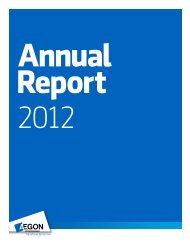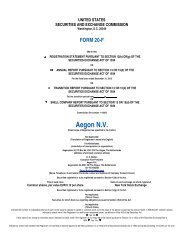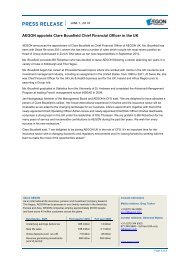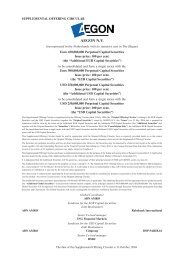Prospectus supplement US007924AH66 - Aegon
Prospectus supplement US007924AH66 - Aegon
Prospectus supplement US007924AH66 - Aegon
Create successful ePaper yourself
Turn your PDF publications into a flip-book with our unique Google optimized e-Paper software.
the time amortizable bond premium offsets interest income, a U.S. holder realizes exchange gain or<br />
loss (taxable as ordinary income or loss) equal to the difference between exchange rates at that time<br />
and at the time of the acquisition of the debt securities. Any election to amortize bond premium shall<br />
apply to all bonds (other than bonds the interest on which is excludible from gross income) held by the<br />
U.S. holder at the beginning of the first taxable year to which the election applies or thereafter<br />
acquired by the U.S. holder and is irrevocable without the consent of the IRS.<br />
Sale, Exchange or Retirement of the Debt Securities<br />
A U.S. holder’s tax basis in a debt security will generally equal its ‘‘U.S. dollar cost’’, increased by<br />
the amount of any OID or market discount included in the U.S. holder’s income with respect to the<br />
debt security and the amount, if any, of income attributable to de minimis OID and de minimis market<br />
discount included in the U.S. holder’s income with respect to the debt security (each as determined<br />
above), and reduced by the amount of any payments with respect to the debt security that are not<br />
qualified stated interest payments and the amount of any amortizable bond premium applied to reduce<br />
interest on the debt security. The ‘‘U.S. dollar cost’’ of a debt security purchased with a foreign<br />
currency will generally be the U.S. dollar value of the purchase price on (1) the date of purchase or<br />
(2) in the case of a debt security traded on an established securities market (as defined in the<br />
applicable U.S. Treasury regulations), that is purchased by a cash basis U.S. holder (or an accrual basis<br />
U.S. holder that so elects), on the settlement date for the purchase. A U.S. holder will generally<br />
recognize gain or loss on the sale, exchange or retirement of a debt security equal to the difference<br />
between the amount realized on the sale, exchange or retirement and the tax basis of the debt security.<br />
The amount realized on the sale, exchange or retirement of a debt security for an amount in foreign<br />
currency will be the U.S. dollar value of that amount on the date of disposition, or in the case of debt<br />
securities traded on an established securities market (as defined in the applicable U.S. Treasury<br />
regulations) that are sold by a cash basis U.S. holder or by an accrual basis U.S. holder that so elects,<br />
on the settlement date for the sale.<br />
Gain or loss recognized by a U.S. holder on the sale, exchange or retirement of a debt security<br />
that is attributable to changes in currency exchange rates will be ordinary income or loss and will<br />
consist of OID exchange gain or loss and principal exchange gain or loss. OID exchange gain or loss<br />
will equal the difference between the U.S. dollar value of the amount received on the sale, exchange or<br />
retirement of a debt security that is attributable to accrued but unpaid OID as determined by using the<br />
exchange rate on the date of the sale, exchange or retirement and the U.S. dollar value of accrued but<br />
unpaid OID as determined by the U.S. holder under the rules described above under ‘‘Original Issue<br />
Discount’’. Principal exchange gain or loss will equal the difference between the U.S. dollar value of the<br />
U.S. holder’s purchase price of the debt security in foreign currency determined on the date of the sale,<br />
exchange or retirement, and the U.S. dollar value of the U.S. holder’s purchase price of the debt<br />
security in foreign currency determined on the date the U.S. holder acquired the debt security. The<br />
foregoing foreign currency gain or loss will be recognized only to the extent of the total gain or loss<br />
realized by the U.S. holder on the sale, exchange or retirement of the debt security, and will generally<br />
be treated as from sources within the United States for U.S. foreign tax credit limitation purposes.<br />
Any gain or loss recognized by a U.S. holder in excess of foreign currency gain recognized on the<br />
sale, exchange or retirement of a debt security would generally be U.S. source capital gain or loss<br />
(except to the extent such amounts are attributable to market discount, accrued but unpaid interest, or<br />
subject to the general rules governing contingent payment obligations). Prospective investors should<br />
consult their own tax advisors with respect to the treatment of capital gains (which may be taxed at<br />
lower rates than ordinary income for taxpayers who are individuals, trusts or estates that held the<br />
debt securities for more than one year) and capital losses (the deductibility of which is subject to<br />
limitations).<br />
42













